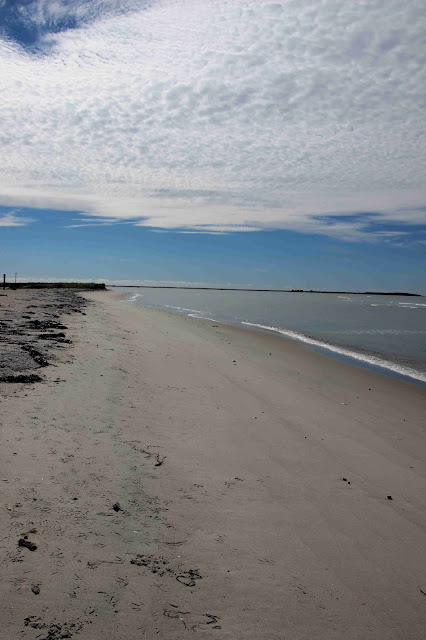By Beth Sullivan
There are some things you can rely
on, events that happen at a certain time, under certain conditions,
every single year. Some for hundreds or thousands and even millions
of years.
One such occurrence is the arrival
of the Horseshoe crabs along the sandy shores here, in the places we
humans now call home. For millions of years, these ancient species
have been pulled by the tides and phases of the moon, to seek mates
and find their way to the safe coastal areas for spawning.
Certainly the shoreline has changed
over that time. Sandy beaches have eroded, disappeared, and
reappeared in new areas. Barrier beaches have been washed away, and
islands have moved, literally. And new islands and sandbars have
appeared in shallows along the edge of the sea. But what has not
changed is the cycling of the moon, its constant pulling on the
waters of the Earth, and the effect it has on the Horseshoe crabs
which, as a species, has remained almost unchanged for many millions
of years.
 |
| Gently sloping beaches and low surf areas are ideal for Horseshoe Crab nests. |
 |
| Sandy Point has drifted over centuries, but continues to offer sanding nesting areas for Horseshoe Crabs |
So, when we head out to Sandy Point
and other local beaches to find and tag the Horseshoe crabs, we
always anticipate that some things will not have changed.
Unusual year
This year was just an odd year for
lots of reasons. The weather did not cooperate around the times of
the full moon and new moon in May. Those are the times when the tides
are most extreme and best for nesting crabs. It is not just that we
humans don’t like going out in windy wet weather, but the crabs do
not like it either. They do not like to come ashore when the surf
is rough. A lot of freshwater-rain runoff into their favored nesting
sites will also keep them away. So May really was a wash-out. I
don’t know where they went, but they were not at all the places I
expected them to be.
 |
| Too much surf can flip a crab or pair of crabs and expose them to predation. |
The early full moon in June really
wasn’t much better for conditions, but we paddled out to Sandy
Point and cruised along the shore. In past years, the north side of
the island would have been the most desirable stretch of sandy beach
for nesting. We found a few pairs along that north shore, and a few
more down toward the extreme eastern tip. But it was discouraging.
We tagged about 15 that night, certainly not close to the dozens or
hundreds of only a few years ago.
Each crab is assessed for size,
condition, and gender. The tags are placed with a peg, into their
shell, the carapace, in an area that will not impede their
functioning. We make notations about certain physical
characteristics including injuries or damage to shell, and also
note all the “baggage” they carry: hitch-hikers that are mollusks
of varying species and seaweeds. The tags bear a number that can then
be tracked when they are recovered at a later date. When we look for
crabs, we always note the “recaptures” and document their
condition and tag number. It reveals interesting data.
 |
| Finding an old tag helps provide data on longevity and and travel patterns. |
Once more we tried with the new moon
phase at the end of June. Technically this should be the real high
point. We have, in the past, counted over 1000 crabs jostling for
space in the sand, jostling for mates, and jostling off competitors.
But not this year.
End of June excitement
Three of us paddled out to the
island. A bit of a wind and rolling waves made it interesting, but on
the north side it was calm and quiet. We got caught in a sudden
downpour but were rewarded by a spectacular rainbow and beautiful
sunset. We noted more pairs of crabs, making their way to shore.
Large females followed closely by their smaller mates.
 |
| The crabs often carry a lot of marine baggage. |
 |
| Tagged crabs are inspected closely for damage and condition. |
We were only
allotted 50 tags for the whole season out on Sandy Point, and we used
them up by the time we got to the eastern tip. And then the action
started. Around the tip and out to the south side where the surf was
a little rougher, we began to count more and more crabs. Singles,
pairs, triples and even a few quads-one female with multiple males.
We found several with older tags, and later investigation showed that
some of them had been tagged more than three years ago, a couple
right there on the island.
As we walked we counted: more than
100 more crabs, all participating in that ancient ritual, on that
particular night. It was a far cry from that year of more than
1000. Something has changed. But for a smaller population, the
moon still pulls them to this island. And something pulls us out to
share in that ritual.
 |
| The adventure provides rainbows, sunsets and moon rise views. |
 |
| Whatever pulls the crabs to Sandy Point, pulls us as well. |
Photographs by Mike Charnetski, Rick
Newton, and Beth Sullivan.

No comments:
Post a Comment